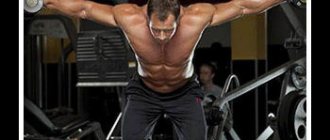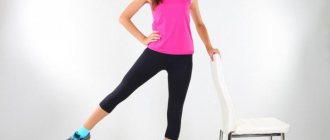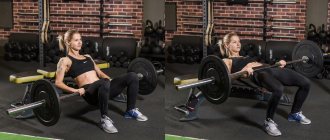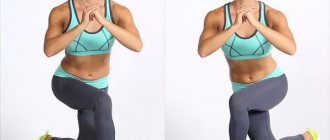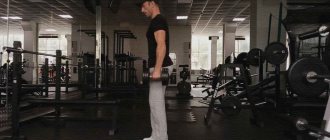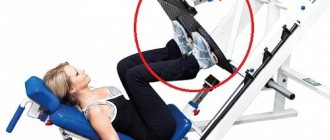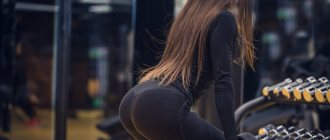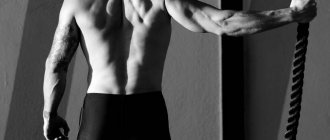Swing your legs while lying on your side
This option uses the gluteus medius muscle, but depending on the offset of the hip from the center, the load on the buttocks is also distributed differently. In the classic version, you need to lie on your side, tightening your abdominal and thigh muscles, and place your upper leg strictly above your lower leg.
The swing is performed in any of the options while exhaling, while the hip rises no higher than 45 degrees. It is important to feel constant tension in the side of the buttocks. And in order to slightly shift the load on the upper part of the gluteus maximus muscle, the thigh must be moved back a little, but without bending the lower back too much.
You need to perform lifts on each side 15-30 times until you feel a burning sensation in the muscles.
Description of the exercise
This exercise is great for training at home, as it does not require any equipment (except weights). But contrary to what quite a lot of people claim, this exercise does not train the gluteus maximus muscle. It trains the gluteus medius muscle. But, since this muscle is located in the same place as the gluteus maximus (immediately below it), it feels like it is the one that is working.
Therefore, leg swings are not suitable for pumping up your butt. More precisely, you cannot use this exercise as the main one. But it is good at the end of a glute workout. Since the gluteus medius muscles still influence the external shape of the buttocks.
Main features
1. It is better not to put your foot on the floor, but only lightly touch the floor. After all, it is desirable that the muscles are always tense.
2. You need to lift it as high as possible, staying at the top for a second. However, if you do not have enough stretch, you can slightly bend your knee.
3. It is advisable to do this exercise with a weight of 1 - 3 kg. If this is not the case, then you can tie a disc or dumbbell with a strap.
4. 4.
When lowering down, the working leg can be brought forward a little to better stretch the buttocks. And when going up, go back a little to better shorten them.
5. This exercise is especially suitable for those who have coxarthrosis of the hip joint and who should not put stress on these joints. Since there is no load on the joints in this exercise.
Leg adduction while lying on your side
And this option develops the adductor surface of the thigh. While lying on your side, your lower leg should be brought forward approximately 45 degrees. The upper leg can be placed on the floor with the knee bent, or held in a vertical position. In the latter option, the lower leg will need to be brought forward at a right angle. This option is more difficult and requires a good balance.
Consider the option with a foot rest. When swinging your leg, it is important not to raise your leg too high, so as not to roll onto your lower back; the load should be felt in the inner thigh. Swings are also performed on each side for 15 to 30 repetitions.
Execution technique
- Lie on the floor, straighten your legs, the supporting arm is extended under the ready one, the “upper” one is directed straight in front of you. The body is straight, there is no flexion at the hip joint. This is the starting position and should be returned to after each repetition of the exercise;
- As you exhale, you need to bring your legs one to the other and lift them up;
- While inhaling, lower to the starting position, working as smoothly as possible.
side leg lift
Swing your legs apart while lying on your back
In this embodiment, the adductor muscles of the thigh will work. To do this, you need to lie on your back, place your arms along your body, and raise your legs to a vertical position. As you inhale, you need to move your legs to the sides, but carefully, without tearing or stretching the muscles as much as possible (do not confuse this with stretching). As you exhale, use your adductor muscles to bring your legs together.
Swing your leg while standing forward
Swinging your leg forward while standing engages the extensor muscles or quadriceps. This option is not the most effective for this area, but by including it in a complex of various swings for all muscle groups, you can significantly increase the fat-burning effect of the training by performing exercises without pauses.
Standing straight, placing your hands on your waist or leaning against a wall, exhale and swing your leg forward without rounding your back. There is no need to try to lift your leg high. Perform the movements without swaying, and so on each side for 15-30 swings.
Swing your leg to the side while standing
When swinging to the side, the gluteus medius and minimus muscles are activated. This is an excellent option for shaping the upper part of the buttocks, making it more rounded and spherical when viewed from the side.
To perform swings, place your hands on your belt or grab a stable support. Exhale and move your leg to the side, without performing sudden or amplitude movements. It is enough to raise your leg 45 degrees up, feeling the work of the gluteal muscles. Just like all options, perform a large number of repetitions on each side until you feel a burning sensation in the muscles.
Abduction (raising) of the straight leg while lying on its side[edit | edit code]
Abduction (raising) of the straight leg while lying on its side
- Isolated/single-joint
- Traction
- Open circuit
- With your own body weight
- Beginner and intermediate levels of physical fitness
This exercise, perhaps more than any other, was popularized in the 1980s by the best-selling book The Jane Fonda Workout. The Oscar-winning film actress was a pioneer in the popularization of aerobics and home workout videotapes.
Exercise technique[edit | edit code]
Slowly lift your right leg to the side and up through the full range of motion, moving it outward. Pause, slowly lower your leg, then repeat the exercise. Roll over to the other side and repeat the exercise for your left leg.
Stabilizing muscles
- Torso: Abdominal muscle group, erector spinae, quadratus lumborum.
INITIAL POSITION
- Lying on your right side, your head rests on your right hand.
- Maintain a horizontal body position and do not bend your lower leg.
Tips on proper exercise technique
:
- Do not allow your pelvis to move forward or backward while performing the exercise; engage your abdominal muscles to stabilize your spine and pelvis.
- Do not externally rotate your hip when lifting your leg.
- Work slowly and do not use inertia.
- Avoid excessive hip abduction.
| Motion Analysis | Joint |
| Joints | Hip |
| Directions of joint movements | Up - abduction (abduction) Down - adduction (adduction) |
| Mobilizing muscles | Gluteus medius and minimus muscles Tensor fascia lata |
Swing your leg back while standing
When you move your leg back, the gluteus maximus muscle is activated, both the outer and deep layers. This is one of the best exercises for the gluteus maximus, which affects size. The exercise can be performed with your own weight, as well as with the help of weights and a fitness band, which will significantly increase the effectiveness of the exercise.
To do this at home, place your hands on the wall at chest level, step back a little so that your torso can lean forward slightly. As you exhale, lift one leg back, without lifting it too high, that is, not above the horizontal line. As you inhale, slowly lower your leg, but do not touch the floor with your foot. Perform the same number of repetitions on each side.
Variations
In addition to the typical exercise, there are several variations. Each type of training is designed for people with different sports backgrounds (beginners, professional athletes and people undergoing rehabilitation measures):
1. Alternating leg raises for beginners. Lie down on a gymnastics mat. Straighten your back and legs. You can place your hands under the lower back or behind your head, clasping them together.
We recommend reading: 8 reasons to take up sports today
Movements: exhaling, raise one leg up to 45-60 degrees. Hold for 2 seconds. Lower your leg completely, touching the heel to the surface. As soon as the lower limb has taken the starting position, raise the opposite leg to the same angle. It is allowed to raise your head during the first few workouts, this will lighten the load a little.
2. Restorative exercise during the rehabilitation period (after surgery of the abdominal cavity, pelvic area, etc.). Lie down on the mat and completely relax. Straighten your back. Place the cushion under your head in the neck area. Keep your arms along your body. Your legs can be slightly bent at the knee. As you exhale, lift one leg, reaching an angle of 90 degrees. Hold for 2 seconds. As you inhale, return to the starting position. Repeat the same with the other limb. At the top point, try to gradually straighten your knee.
Before performing this exercise, you should consult a specialist. The doctor will prescribe the required load. Independent training is strictly prohibited. Leg lifts are contraindicated for pregnant women, since the main load falls on the lower abdomen, and an overly toned abs makes labor difficult.
3. Simultaneously raise your legs to an angle of 45-60 degrees. This exercise option is suitable for athletes with average physical fitness.
The initial position is identical to the classic version, i.e. horizontally. Raise your legs simultaneously to an angle of 45 or 60 degrees. At the end point, fixate for 2-3 seconds. As you inhale, return to the starting position without your heels touching the surface, maintaining a distance of 2-3 centimeters.
To simplify the exercise, full contact of the legs with the surface is allowed. This way the abs will rest, but this makes the workout less effective.
4. Weighted leg raises. If your abdominal muscles are developed and there is a need to increase the load, this variation is just for you. The technique is similar to the classical one. Only here it is necessary to attach a weighting agent to each lower limb or hold the dumbbell with your ankles. The weight of the weighting agent is selected for each athlete individually. Raising the legs is carried out to an angle of 45 or 60 degrees. Do not touch the floor with your feet, but leave a distance of 3-4 centimeters. Perform the required number of approaches and repetitions.
5. Lying on your stomach. Starting position: lie on your stomach. Stretch your arms forward. Close your legs together. As you exhale, alternately lift your lower limbs up. Try to fix your hips as much as possible. They are not allowed to be torn off the floor.
We recommend reading: Eternal course of steroids
6. Leg raises while lying on your side. Lie on your side. Bend your arm at the elbow and rest on it. Legs straight. Technique: while exhaling, raise the lower limb as high as possible. Make sure that your leg does not bend at the knee joint. Perform the required number of times and change the position of your body, turning over to the other side.
Each leg lift option can be performed on training equipment or on a regular flat bench. The training does not require additional equipment, so it can easily be done at home.
Swing your leg back while on all fours
The target muscle is the gluteus maximus. Swings can be performed in two versions - with a straight or bent leg. Regardless of the option chosen, the effect will be achieved when a burning sensation occurs in the buttocks.
In order to prevent excessive deflection in the lower back, it is better to perform such swings on the forearms, placing the elbows under the shoulder joints. The knees must be positioned strictly under the hip joint, slightly apart to the sides. One leg swing is performed while exhaling using the gluteus maximus. Tighten your abs to avoid excessive arching in the lumbar region. Switch sides and perform the same number of repetitions.
Read more about back leg swings on the ground →
Swing your legs from a prone position
I liked this exercise for the muscles of the buttocks and thighs because it not only strengthens the muscles of the butt and thighs, but also perfectly tightens the back muscles. You may not be able to do some elements right away. This is not scary at all, since with regular training the exercise will become better and better every day. I was able to do this exercise for the buttocks correctly only after 3 weeks of training. But the effect of this exercise is really high.
You need to lie on your stomach, bend your arms at the elbows and place them comfortably in front of you, you can lie face down on your hands. The left leg should be extended straight, and the right leg should be turned as far as possible to the side. It will be ideal if there is a 90 degree angle between your legs, although this will depend on your stretch. The left leg rises up as high as you can, while the knee is straightened with all its might, the toes are extended, and the leg is lifted using the gluteal muscle. Perform this exercise for the buttocks and thighs 20 times, and then change legs.
Pay attention to the most difficult part of the exercise: the same starting position, only now you need to put your hands on the back of your head and lift your upper body at the same time as your left leg. The exercise is repeated for both legs 15 times. I find this a very difficult task because the body and leg refuse to work in sync. If you manage to raise the body high, then the leg rises only a few centimeters, but when the leg is raised high, the body practically does not rise. But time passed, and I learned to do this exercise for the buttocks and thighs. Now it is one of my favorite exercises.
Swing your leg to the side while on all fours
When moving the leg to the side, the gluteus medius muscle is loaded to a greater extent. Of course, this does not mean that the large and small groups do not work at all, it’s just that the main load in the lateral leads still falls on the middle group.
From the previous position: on all fours, the swing is performed while exhaling with the leg bent to the side. In this case, the torso should not fall to the side, and the back should not take unnecessary bends, so always tense your abdominal muscles for better fixation of the spine. As usual, swings are performed on each side. You can also swing with a straight leg, but this option is much more difficult and inconvenient.
How to incorporate swings into your workout
- In order to correctly distribute the load on all muscle groups, perform one of the options on a specific bunch of the gluteal or thigh. It doesn't matter whether you alternate between a standing swing and a lying one, as long as you work different areas. For example, standing back swings are for the gluteus maximus, lying on your side swings are for the gluteus medius, and back swings are adductors.
- One exercise is enough for each part of the gluteal muscles or thigh.
- You can perform the exercises one after another without a break for 3-4 laps, or give each option 3-4 approaches with a rest of no more than one minute between sets. It all depends on preparation and feelings. In order to burn fat, it is better to perform exercises non-stop.
A complex consisting of swings, as well as exercises for other parts of the body, should not be performed more than three times a week.
And also read: Leg scissor exercise → Crossover leg abduction → How to pump up your buttocks without squats and lunges →
Effective training complex
The second thing you need to pay attention to is training. Undoubtedly, they will lead you to results much faster. I will show you several exercises that will help in the fight against “ears”.
Swing your leg while lying on your side
Lie sideways on the floor, rest your head on your arm bent at the elbow, the other can be directed towards the ceiling or placed in front of you. The leg on the bottom should be bent at the knee, and the other should be straightened. Raise your top leg, stay in this position for a second and then lower it. Repeat these movements 20-25 times.
Hip abduction lying on the floor
Lie on your side, rest your head on your bent arm. The leg on the bottom is bent at the knee, the shin is pointed at the ceiling with the toe up. Place the other leg on top, also bent. Perform hip abduction with your top leg while pointing your knee toward the ceiling. Return to the starting position and repeat the movements 25 times.
Side lunges
Stand up straight. Take a fairly wide step to the side and squat on one leg, the other should be straightened. Push up with your lunge leg and return to the starting position. It is important to push off with your heel, tensing your gluteal muscle. Try not to lean your body forward. It is necessary that the movement occurs not in the lower back, but in the hip joint. Perform 20-25 repetitions.
Diagonal lunges
Stand straight, feet hip-width apart. Lunge back diagonally behind your other leg. Next, pushing out the pelvis with the gluteal muscle, return to the starting position. Repeat the movements 20 times.
Do this set of exercises without rest, alternately first on one leg, then on the other leg. I recommend doing 4-5 laps per workout.
An effective set of exercises for the legs and buttocks. The muscles will burn
